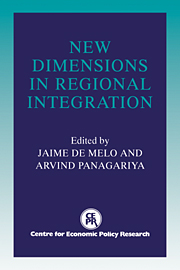Book contents
- Frontmatter
- Contents
- List of figures
- List of tables
- Preface
- Foreword
- Acknowledgements
- List of conference participants
- PART ONE SYSTEMIC ISSUES
- PART TWO COUNTRY ISSUES
- 6 The new regionalism: a country perspective
- Discussion
- 7 The European Community: a case of successful integration?
- Discussion
- 8 Regional integration in Sub-Saharan Africa: past experience and future prospects
- Discussion
- 9 Latin America's integration and the multilateral trading system
- Discussion
- 10 Regional integration in Eastern Europe: prospects for integration within the region and with the European Community
- Discussion
- 11 Regional trade arrangements in North America: CUSTA and NAFTA
- Discussion
- 12 Trading blocs and East Asia
- Discussion
- 13 Prospects for regional integration in the Middle East
- Discussion
- Round Table Discussion
- Index
Discussion
Published online by Cambridge University Press: 04 May 2010
- Frontmatter
- Contents
- List of figures
- List of tables
- Preface
- Foreword
- Acknowledgements
- List of conference participants
- PART ONE SYSTEMIC ISSUES
- PART TWO COUNTRY ISSUES
- 6 The new regionalism: a country perspective
- Discussion
- 7 The European Community: a case of successful integration?
- Discussion
- 8 Regional integration in Sub-Saharan Africa: past experience and future prospects
- Discussion
- 9 Latin America's integration and the multilateral trading system
- Discussion
- 10 Regional integration in Eastern Europe: prospects for integration within the region and with the European Community
- Discussion
- 11 Regional trade arrangements in North America: CUSTA and NAFTA
- Discussion
- 12 Trading blocs and East Asia
- Discussion
- 13 Prospects for regional integration in the Middle East
- Discussion
- Round Table Discussion
- Index
Summary
Chapter 11 is well-written, well-balanced, and well-documented. Whalley makes several provocative points, but since they are safely hedged, there is only a limited room for discussion without stepping beyond the scope of the chapter. I therefore divide my comments into two parts, a general comment, followed by two specific points of discussion.
At a general level, Whalley is disappointed with the actual limited outcome of the Canada–US Free-Trade Agreement (CUSTA) compared with the initial expectations and claims of important trade, investment, and welfare gains. However, when appraising the outcome of small Central and South American countries seeking membership in a trade bloc, WTialley succumbs to reality by stating that the bloc might impose such conditions that these countries would end up worse off than countries outside the bloc (e.g., African and Asian countries). In making this assertion, Whalley seems implicitly to be assuming that those countries outside the bloc will be better off because they will operate in a freer trade environment, or at least in a more cooperative negotiating framework. But perhaps the main reason why there has been a global tendency towards regional arrangements in the trading system during the 1990s is precisely the absence of such a free-trade environment in the real world.
I have two specific comments. First, while assessing CUSTA and the likely outcome of the North American Free-Trade Agreements (NAFTA), Whalley stresses the contrast between both agreements in terms of the limited outcome of the former and the strong effects on trade and investment of the latter even before it is ratified.
- Type
- Chapter
- Information
- New Dimensions in Regional Integration , pp. 382 - 387Publisher: Cambridge University PressPrint publication year: 1993

